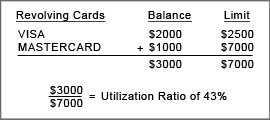


How do My Balances Owed Affect My Credit Score?

Technically, your utilization ratio is calculated by taking all your revolving accounts (i.e., credit cards, charge cards) and dividing your aggregate balance by your aggregate limit. For example, if you have a credit card with a credit limit of $2500 and another card with a credit limit of $4500, then your aggregate credit limit would be $7000. If the amounts owed on the cards were $2000 and $1000 respectively - totaling $3000 - this would be a utilization ratio of 43% ($3000 divided by $7000).

How Many Cards is Too Many?
The number of credit cards you have does not affect your credit score in a negative way. In fact, it helps it. The more accounts you have to demonstrate your ability to make payments on time builds your payment history… the biggest factor in the credit score equation. Of equal importance is whether the creditors are reporting each month to the credit reporting agencies (CRAs).
If you have a credit card that you haven’t used for a year or more and the creditor has not reported any activity, then that account isn’t helping your score. To help your score, the creditor needs to report each month to the CRAs. Simply using the card and paying it off each month, or carry a small balance, ensures that the account will be reported to the CRAs.
MYTH: Some people have been led to believe that having a lot of available credit limit will reduce your credit score.
FACT: Having a lot of credit available does not affect your credit score. Even if you had a $100,000 credit limit that has a $0 balance… meaning that you could actually go out and spend $100,000 today, has no impact on score. The things that do affect your score are 1) making your payments on time, 2) the length of your payment history on the account - how long you’ve had it, 3) the utilization ratio of your revolving accounts, and 4) the total amount of debt you carry and how long you’ve demonstrated being able to handle the payments.
Think Twice Before Closing a Credit Card Account
A common mistake people make when trying to reduce their debt is paying off a card and then closing the account. While it is good to pay off debt, by closing the card they have also reduced their total available credit limit which affects the ratio calculation. Using the previous example: if you transfer the $2000 balance from the first credit card to the second card that has the higher credit limit of $4500, and subsequently close the first credit card account, then your total balance of $3000 would be on the card with a $4500 credit limit. Your utilization ratio would then be 66%. This higher ratio will have a large impact on reducing your score; possibly by 50 points or more.
One solution to reduce the utilization ratio is to contact the credit card issuer and ask them to raise your credit limit. This may seem contrary to common sense since you are increasing your spending capacity and the risk to the card company, however as mentioned above, this does not affect your credit score. Your utilization ratio does impact on your score.
Note that if you are being charged higher interest rates (over 21%) on a credit card, you've probably paid your bill past the due date or gone over the credit limit. When this happens, the credit card company assigns a higher risk "coding" on your account, which are used in your score calculation. High-risk finance companies also assign a code which indicates to the bureaus that you are a higher risk borrower. This affects your score even though you are never late on your account.
*For all consumers
*For members only
*Coming Soon
Credit Management Principles
- What Lenders Look at When Applying For Credit
- Properly Managing Revolving Debt - Credit Cards
Members Only
- Preferred Number of Trade Lines
- Recentness of Trade Line Activity
- Length of Credit History
- How Late Payments Occur - Keys to Awareness
- Positive vs. Negative Credit Iitems - The Lopsided Effect
- Paying Off Collections or Defaulted Accounts
- Understanding Debt-to-Income and its Impact on Financing
Credit Restoration
Establishing Positive Credit
Members Only
- How to Establish New Accounts
- Active vs. Closed Accounts
- When Not to Apply For Credit
Rapid Rescore
Members Only
Debt Validation
